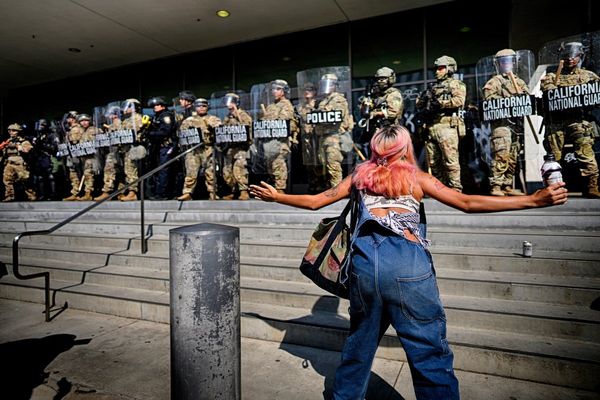
When Andy Hill started to engage schoolboys in masculinity workshops six years ago, he noticed that children didn’t seem to warm to one phrase in particular. “We were trying to address the concept of toxic masculinity,” he says. “It was very common language at that time. But the more work we did with young people, the more we found that when we use this kind of terminology, it just led to this immediate sense of defensiveness.”
Hill is the Creative Director of Voicebox, a charity that aims to help boys aged nine to 16 to thrive against a backdrop of declining school performance, increased scrutiny of misogyny and violence against women and girls, and a broader sense that boys are being left behind. Voicebox is one of several charities that have positioned themselves in recent years as mentors for young men, in part to act as a counterbalance to “harmful ideas of masculinity”.
Out of nine charities working predominantly with children that The Independent has contacted, eight of them say that they too now avoid the term. The charity sector’s re-evaluation of “toxic masculinity” may be a sign that something is shifting in attitudes towards boys.
“The aim of Voicebox was to engage boys in conversations to reflect on these harmful ideas,” says Hill. “But when they heard the phrase ‘toxic masculinity’, what they heard was, ‘You are toxic; you are the problem.’” Six years on, Voicebox has adapted its approach to “empower participants to promote and embody healthy masculinity”. “Boys are not inherently toxic, and they’re not inherently problematic,” he says. “They’re struggling, and we need to reframe the way we’re talking about them.”
Toxic masculinity is a loosely defined term that is used to refer to stereotypical norms of masculinity that are currently perceived as undesirable, such as domination, the devaluation of women, homophobia, stoicism, aggressive competition and violence.
To Hill, many of the traits associated with toxic masculinity have a ‘healthy’ and ‘unhealthy’ expression – which is why he prefers to talk about masculinity in these terms. “Loyalty, courage, strength, bravery, competitiveness, aggression – all of these things are not inherently bad,” he says. “It’s about how they’re channelled.”
Voicebox is not the only organisation adopting a masculinity-positive approach. In May, the prime minister, Keir Starmer, invited several charities to attend a meeting to discuss “how to prevent young boys being dragged into a ‘whirlpool of hatred and misogyny’”. 'But all of the named attendees bar one – the NSPCC – has since told The Independent that they avoid the term “toxic masculinity”.

“Forefronting the word masculinity with a negative adjective like ‘toxic’ is not something that we feel is a good way of moving these conversations forward,” said Kirsty Ruthven, from The Children’s Society, which works with teachers in primary schools to challenge gender stereotypes. “It’s important to label the harmful behaviours and outcomes for what they are. So if we are talking about coercion, if we are talking about violence, if we are talking about misogyny, we need to talk about that, and not this vague umbrella of ‘toxic’ that could mean different things to different people.”
Tender CEO Susie McDonald MBE says that the charity prefers to talk about “misogynistic behaviours” to separate these harmful traits from masculinity in general. “We need to support boys and young men in building confidence, compassion, and healthier attitudes, rather than demonising them,” she says. “Ultimately, they are part of the solution.”
Charities set up to tackle violence against women and girls have dropped the term too. A spokesperson for Everyone’s Invited, a charity established to “expose and eradicate rape culture”, said that they don’t use it either. “We were at a school a few years ago, and a boy shared with us how painful it was to hear masculinity constantly described as ‘toxic’,” they said. “Many of the boys we work with feel the same. The language we use is important. We want to open up honest dialogue, and we must ensure that we don’t alienate the people we need most in it.”
The phrase is “unhelpful, stigmatising and oversimplifies complex issues”, according to Rebecca Cant from relationship charity Brook, which works with children in schools across the country.
The charity sector’s re-evaluation of “toxic masculinity” may be a sign that something is shifting in attitudes towards boys. It’s a phrase that is easily applied to men like Andrew Tate; it’s less easy to explain to a classroom of nine-year-olds that their behaviours could be toxic.
In Westminster, however, the fervour around “toxic masculinity” has perhaps never felt stronger, thanks to the influence of Netflix drama Adolescence, which depicts a hypothetical scenario of adolescent femicide via manosphere radicalisation. Starmer said in March that he is “worried” about the influence of “callous, manipulative and toxic influencers” on boys. His intervention has been regarded as a double-edged sword by campaigners who have been trying for years to encourage empathy for schoolboys, who have slipped into a recession of educational performance, employment, pay and life expectancy relative to girls. That boys are now receiving attention over fears they could murder their classmates has not been well received by all.
The prime minister appears to have been careful not to use the exact phrase “toxic masculinity”. His key intervention – the publication of new guidance by the Department for Education for new school lessons to tackle misogyny – contains signals that the government is aware that it is contentious. The guidance does not use the term, and repeatedly stresses the importance of avoiding “stigmatising or perpetuating harmful stereotypes about boys”.
This may come as news to the chair of the education select committee, Labour MP Helen Hayes, who expressed concern about children’s “exposure to toxic masculinity” in a debate on the educational attainment of boys just days prior to the launch. The education secretary Bridget Phillipson, meanwhile, railed against “violent, toxic masculinity” as recently as 2023. In a parliamentary debate on tackling violence against women and girls in May, the Labour MP Fleur Anderson praised the work of charity White Ribbon, “which tackles toxic masculinity head-on in the school”. White Ribbon is another charity that says it prefers not to use the phrase.
“We don’t think the term ‘toxic masculinity’ is very helpful,” says Lynne Elliot, CEO of the 34-year-old charity established to prevent violence against women and girls. “Masculinity isn’t toxic, and many traits of masculinity are really positive. We work with thousands of men each year who work hard to change those gender stereotypes and who stand up and speak out for women and girls. They tell us that the phrase ‘toxic masculinity’ can come across as blaming men, and alienates them.”
Parliamentarians who are otherwise sensitive to sweeping generalisations have been slow to pick up on the trend away from the phrase. The term remains ubiquitous in politics and media, and has been mentioned 31 times in parliament – but on only five of those occasions presented critically or unfavourably. The reality is, however, that almost as soon as it entered popular discourse, critics have argued that the phrase “toxic masculinity” perpetuates harmful stereotypes about boys, and that this harm has largely gone unexamined.

In 2023, researchers set out to examine the impact of positive and negative messages around masculinity on 4,000 men. “Thinking masculinity causes you to engage in bad behaviour (eg inclined to be violent towards women) was correlated with worse mental wellbeing,” says John Barry, the author of the study and the co-founder of the Male Psychology Section of the British Psychological Society, and The Centre for Male Psychology. “But thinking masculinity causes you to engage in good behaviour (eg inclined to be protective towards women) was correlated with good mental wellbeing. A key question is where these beliefs come from, and my guess is the negative beliefs are being promoted daily in the media, academia, governments, NGOs, etc. And these messages impact men.”
Critics of the phrase “toxic masculinity” argue that it elides toxicity with masculinity itself. Even its logical opposite, “non-toxic masculinity”, implies that toxicity is the default state.
“No matter what people claim they mean by the term, it’s much too easy for it to sound negative, especially in a culture where negativity about men and masculinity is fairly common,” says Barry. “If you think about terms like ‘toxic Blackness’, ‘toxic femininity’ or ‘toxic Islam’, it suddenly becomes clear that it’s difficult to combine the word ‘toxic’ with any demographic without it sounding pretty damning of that demographic.”
In saying that bad behaviour is caused by masculinity, the real causes of criminality in men (as in women) are overlooked
It is important not to deny the realities of gender-based violence. The threat posed to women by men is grounded in a prosaic fact: almost all men are stronger than almost all women. Even well-trained, athletic women are weaker than average men. This is indisputable and exists outside of ideas about the mutability of gender. All boys, as they develop, face the question of whether they will use their strength for good or bad, and most boys are disinclined towards – or successfully socialised out of – violence against women and girls.
Men nevertheless account for 96 per cent of the prison population, 99 per cent of rape convictions and the vast majority of violence against women and girls. The National Centre for Domestic Violence estimates that one in four women (compared to one in seven men) will experience domestic abuse in their lifetime. Boys are much more outwardly violent than girls (and a great deal more violent to each other than they are to the opposite sex). Because these statistics demonstrate a clear gender disparity, it follows that they are in some sense downstream from masculinity.
But the majority of men and boys are not abusers. The major concern of researchers is that discussions about masculinity in schools risk demoralisation and alienation when they exclude positive framings of masculinity and focus relentlessly on the harm caused by a minority. “We shouldn’t talk about the statistical minority as if they are the majority,” says Barry. “There will probably always be a hard core of damaged boys that, for one reason or another, tend towards bad behaviour. But that doesn’t mean we should talk to all boys as if they are potential rapists.”
Barry argues that policymakers’ attention would be better spent on variables that predict criminal behaviour with higher accuracy than gender. “In saying that bad behaviour is caused by masculinity, the real causes of criminality in men (as in women) are overlooked,” says Barry. “The real causes are things like adverse childhood experience, such as childhood neglect or sexual abuse.”
In the meantime, there is a question mark over how children will respond to Starmer’s new school lessons. Throughout the 20th century, teachers warned children about smoking, casual sex, drugs, rock’n’roll and gender nonconformity. All of these things came to define the counterculture of their respective generations. Politicians who frame masculinity as taboo allow its definition to be shaped by people like Andrew Tate, whose resonant message of cynical self-interest feeds on the invalidation and alienation of young men. As the charities working with boys have suggested, this is not a desirable outcome. Tate’s advocacy of violence, misogyny, polygamy, and machiavellianism is the basis for a dog-eat-dog society of hostility, exploitation and fear. It remains to be seen how the kids will react.
Meghan Markle shares details of 44th birthday celebrated with ‘top five’ meal
What is ‘purpose anxiety’? The burden of searching for meaning
Michelle Obama reveals what initially attracted her to Barack
Good Morning Britain presenter ‘ashamed’ after losing savings to scammers
Do you have back pain? Here’s what could be causing it
The devices that could help young drivers lower car insurance costs







